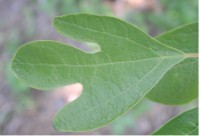Difference between revisions of "AY Honors/Edible Wild Plants/Sassafras"
From Pathfinder Wiki
m (W126jep moved page Adventist Youth Honors Answer Book/Edible Wild Plants/Sassafras to AY Honors/Edible Wild Plants/Sassafras without leaving a redirect: Part of translatable page "Adventist Youth Honors Answer Book/Edible Wild Plants/Sassafras") |
|||
| (4 intermediate revisions by the same user not shown) | |||
| Line 1: | Line 1: | ||
| − | {{EWP | + | <noinclude><translate><!--T:1--> |
| + | </noinclude> | ||
| + | {{ | ||
| + | |||
| + | <!--T:2--> | ||
| + | EWP | ||
|name = Sassafras | |name = Sassafras | ||
|image = Sassafras1980.jpg | |image = Sassafras1980.jpg | ||
| Line 7: | Line 12: | ||
|use = dig up the roots, peel them, and boil them to make a rootbeer-like tea. | |use = dig up the roots, peel them, and boil them to make a rootbeer-like tea. | ||
|warning = Safrole, which is the main component (75-80%) of sassafras essential oil, is now recognized by the United States Department of Agriculture as a '''potential''' carcinogen. | |warning = Safrole, which is the main component (75-80%) of sassafras essential oil, is now recognized by the United States Department of Agriculture as a '''potential''' carcinogen. | ||
| + | |||
| + | <!--T:3--> | ||
}} | }} | ||
| + | <!--T:4--> | ||
<noinclude> | <noinclude> | ||
{{EWP/Boil}} {{EWP/Beverage}} | {{EWP/Boil}} {{EWP/Beverage}} | ||
[[Category:Adventist Youth Honors Answer Book|{{SUBPAGENAME}}]] | [[Category:Adventist Youth Honors Answer Book|{{SUBPAGENAME}}]] | ||
</noinclude> | </noinclude> | ||
| + | <noinclude></translate></noinclude> | ||
Latest revision as of 17:12, 7 September 2021
Sassafras
Description: Sassafras is a small tree with brown, furrowed bark. The leaves come inthree shapes: an oval (one lobe); a mitten (two lobes); and a glove (three lobes).
Where found: Eastern US, west to eastern Texas, north to Illinois, east to New Hampshire.
Use: dig up the roots, peel them, and boil them to make a rootbeer-like tea.
WARNING: Safrole, which is the main component (75-80%) of sassafras essential oil, is now recognized by the United States Department of Agriculture as a potential carcinogen.

